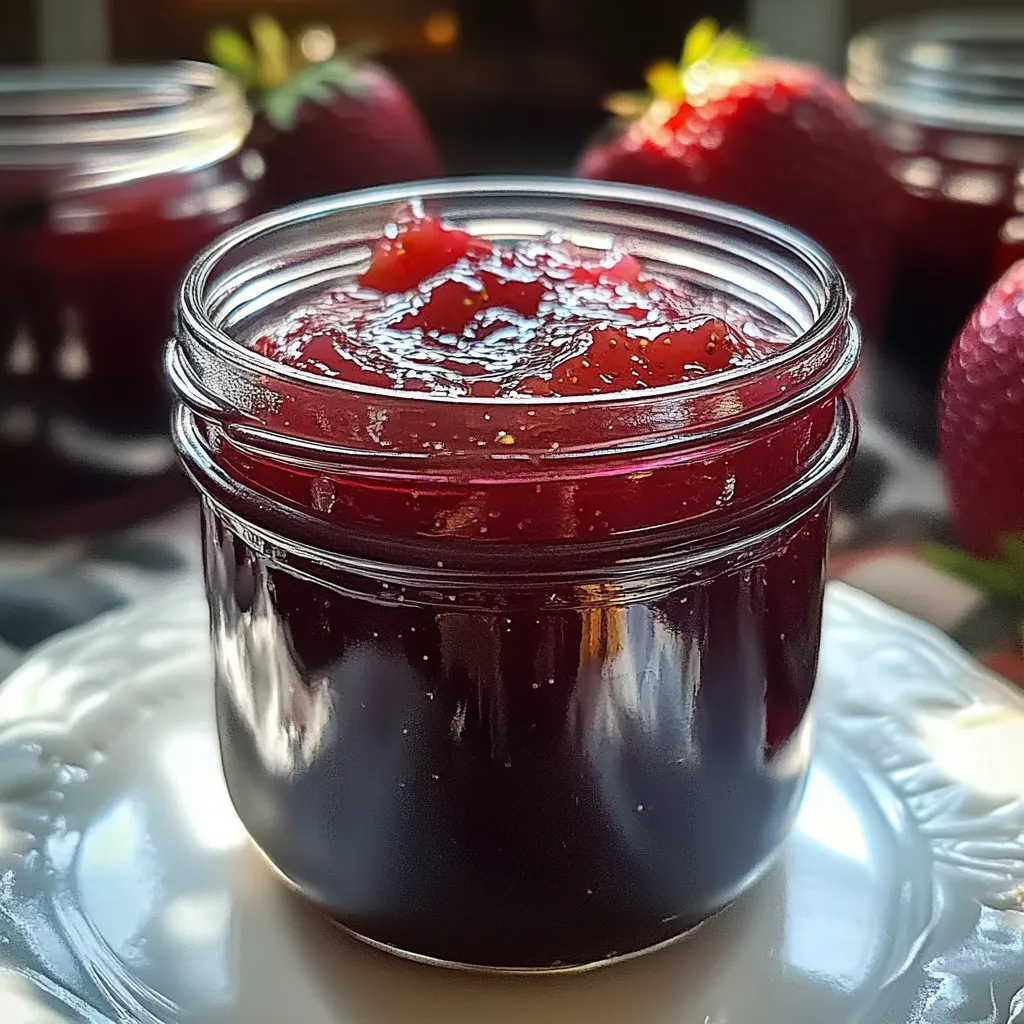 Pin it
Pin it
This vibrant strawberry rhubarb jam captures the perfect balance of sweet and tangy flavors in every spoonful. The rich ruby color and silky texture make it an irresistible addition to morning toast, afternoon scones, or even as a glaze for roasted meats. Each batch brings me back to summer afternoons in my grandmother's kitchen where this recipe was perfected over generations.
I first made this jam when I inherited my grandmother's recipe box after she passed. The stained index card with her handwriting became my most treasured kitchen possession, and now my children request this jam year after year when strawberries and rhubarb appear at our farmers market.
Ingredients
- Rhubarb: 5 cups, cut into ½ inch cubes. Select firm stalks with vibrant color for the best flavor and texture
- Strawberries: 2 cups, hulled and halved. Choose ripe but firm berries with deep red color throughout
- Sugar: 2¼ cups. The exact amount provides both sweetness and helps with preservation
- Lemon juice: 1 tablespoon fresh. Adds brightness and helps the natural pectin activate
- Vanilla extract (optional): 1 teaspoon. Adds subtle depth to the fruit flavors
- Ground ginger (optional): ½ teaspoon. Brings a gentle warmth that complements the rhubarb
- Cinnamon (optional): ¼ teaspoon. Creates a homey aroma and subtle spice note
Step-by-Step Instructions
- Prepare the Fruit:
- Wash rhubarb stalks thoroughly and trim off any leaves which are toxic. Cut into ½ inch pieces. For strawberries remove the green tops and slice larger berries in half. Having uniform pieces ensures even cooking and a consistent jam texture.
- Combine Ingredients:
- Add chopped rhubarb strawberries sugar and lemon juice to a heavy bottomed medium to large saucepan. The high sides prevent splattering as the mixture bubbles. Stir gently to combine ensuring sugar coats all the fruit pieces.
- Initial Cooking:
- Place saucepan over medium heat and bring to a gentle boil stirring occasionally with a wooden spoon to prevent sticking. The fruit will begin releasing juices creating a vibrant red syrup. This should take about 10 minutes.
- Low and Slow Simmering:
- Reduce heat to medium low and continue cooking for approximately 50 minutes stirring every 5 to 7 minutes. You will notice the mixture gradually thickening as excess water evaporates. If using optional spices add them during the last 15 minutes of cooking.
- Test for Doneness:
- After about an hour the jam should coat the back of a spoon and slowly drip off rather than run off in a liquid stream. Place a small plate in the freezer for 5 minutes then add a teaspoon of jam. If it wrinkles slightly when pushed with your finger the jam has reached the setting point.
- Jarring the Jam:
- Ladle hot jam into sterilized glass jars leaving ¼ inch headspace at the top. Wipe rims clean with a damp paper towel to ensure proper sealing. Place lids and bands on jars and tighten to fingertip tight.
- Process for Storage:
- For long term storage place filled jars in a water bath canner ensuring water covers jars by at least 1 inch. Bring to a boil and process for 10 minutes at sea level add 5 minutes for elevations above 1000 feet. Remove jars and allow to cool undisturbed for 24 hours before checking seals.
The humble rhubarb is truly the star of this recipe. Often overlooked as just a garden plant my grandmother taught me to appreciate its complex tartness. She would say good jam needs that perfect counterpoint to sweetness which is why rhubarb creates such a memorable spread that store bought versions can never quite match.
Troubleshooting Your Jam
If your jam seems too thin after cooling resist the urge to reboil it immediately. Sometimes it takes a full 24 hours to reach its final set. For jam that remains too runny after cooling completely you can return it to the pot and simmer for an additional 10 minutes then reprocess. If your jam becomes too thick stir in a tablespoon of water when serving to loosen the consistency. Dark spots in your jam are usually from overcooking or scorching at the bottom of the pan so maintain a gentle simmer and stir frequently.
Seasonal Variations
While the classic strawberry rhubarb combination is unbeatable this jam base welcomes creative adaptations throughout the growing season. In early summer try replacing half the strawberries with raspberries for added complexity. Mid summer brings opportunities to incorporate blueberries which create a deeper purple hue and add antioxidants. Fall variations might include adding diced apple and increasing the cinnamon for a harvest flavor. Whatever the season maintain the same total volume of fruit for consistent results.
Beyond Toast
This versatile jam shines in applications well beyond the breakfast table. Warm a few tablespoons to create a luxurious topping for vanilla ice cream or pound cake. Blend a spoonful into homemade vinaigrette for a fruity twist on salad dressing. Use as filling between cake layers for a spring dessert. For entertaining create an elegant appetizer by topping crostini with goat cheese and a dollop of jam. My personal favorite is stirring a tablespoon into plain yogurt with toasted almonds for a quick breakfast parfait.
The History in Your Jar
Strawberry rhubarb jam carries rich cultural significance particularly in American and European farmhouse cooking traditions. Rhubarb originally from Asia was primarily used medicinally until the 18th century when sugar became more affordable and its culinary applications expanded. Farm wives preserved the spring rhubarb harvest with early strawberries creating this classic pairing out of seasonal necessity. In many families like mine jam recipes were treasured and passed down through generations often one of the first preserving skills taught to children. Each jar connects us to this history of seasonal eating resourcefulness and kitchen wisdom.
 Pin it
Pin it
Frequently Asked Questions
- → Can I use frozen strawberries and rhubarb?
Yes, you can use frozen strawberries and rhubarb. Thaw them beforehand and drain any excess water.
- → How long does strawberry rhubarb jam last?
Properly sealed jars stored in a cool, dark place can last up to 1 year. Refrigerated opened jars last for 2–3 weeks.
- → Can I reduce the sugar in the jam?
Yes, but sugar contributes to both the flavor and preservation. Consider adjusting slightly or using a low-sugar pectin.
- → Do I need to sterilize the jars?
Sterilizing jars is essential to prevent contamination and ensure the jam remains safe for consumption.
- → What can I add to customize the flavor?
Try spices such as vanilla, cinnamon, or ginger to add depth. You can also incorporate orange zest for a citrus twist.
